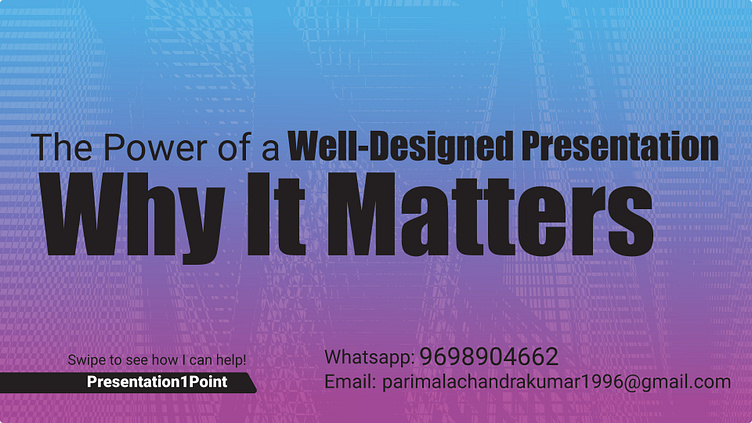The Power of a Well-Designed Presentation: Why It Matters
The Power of a Well-Designed Presentation: Why It Matters
In today’s fast-paced world, presentations are more than just a way to share information – they are powerful tools for communication, persuasion, and storytelling. Whether you’re pitching a new idea, delivering a sales presentation, or teaching a class, how your content is presented can make or break your success. This is where professional presentation design plays a crucial role.
Why Presentation Design Matters
First Impressions Count
A visually appealing presentation grabs your audience’s attention in seconds. On the other hand, a poorly designed slide deck can make even the most compelling content seem unprofessional or uninteresting. A well-designed presentation establishes credibility and sets the tone for your message.
Simplifies Complex Information
Presentations often involve complex information and concepts. Through the proper use of visuals, charts, and infographics, you can simplify these complexities, making the content easier to understand and remember. Data visualization is especially important in business and academic presentations.
Keeps Your Audience Engaged
Let’s face it: no one likes to read slides filled with blocks of text. Compelling visuals, consistent branding, and creative layouts can keep your audience engaged from start to finish. A well-designed slide deck not only holds attention but also reinforces key messages.
Reflects Your Professionalism
Your presentation is a reflection of you and your brand. Investing in professional design shows that you value quality and take your work seriously. This is especially important when presenting to clients, stakeholders, or potential investors.
Key Elements of Effective Presentation Design
To create a powerful presentation, keep these principles in mind:
Continuity: Use a consistent color palette, font, and layout throughout your slides.
Clarity: Avoid overly crowded slides. Use bullet points, concise text, and clear visuals.
Storytelling: Design your slides to support the flow of your narrative. Each slide should build on the previous one.
Visual hierarchy:
Highlight key points with large fonts, bold colors, or distinctive shapes to guide your audience’s focus.
Branding: Include your brand’s logo, colors, and style to maintain a professional look.
Why hire a professional presentation designer?
While tools like PowerPoint and Canva make it easy to create slides, professional presentation designers bring expertise to crafting visually engaging and impactful presentations tailored to your audience. Designers understand the nuances of layout, typography, and visual communication, ensuring that your message stands out and resonates.
At the end of the day, a presentation isn’t just about sharing information; it’s about leaving a lasting impression. By working with a professional designer, you can enhance your content, tell your story effectively, and achieve your goals.
Final Thoughts
A well-designed presentation is an investment in your success. Whether it’s a business pitch, a training session, or a keynote speech, design matters. It’s not just about looking good—it’s about communicating effectively, engaging your audience, and getting results.
Are you ready to take your presentations to the next level? Let’s work together to create slides that captivate and inspire!
